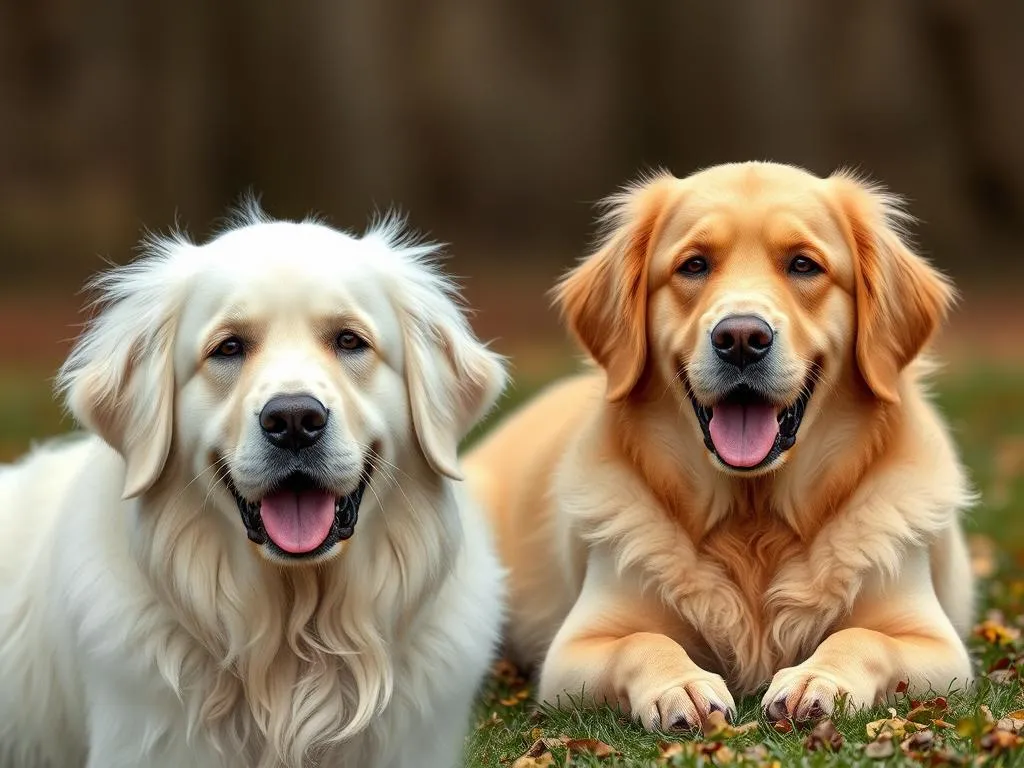
When it comes to selecting a dog breed, the choice can significantly impact your lifestyle and home environment. Two popular breeds often compared are the Great Pyrenees and the Golden Retriever. Both dogs have unique qualities that make them beloved companions, but they serve different purposes and have distinct characteristics. In this article, we’ll dive into a detailed comparison of these two breeds, exploring their origins, physical traits, temperaments, exercise needs, and more.
Breed Overview
Great Pyrenees
The Great Pyrenees, also known as the Pyrenean Mountain Dog, has a rich history that dates back over 6000 years. Originating in the mountainous regions between France and Spain, these dogs were bred primarily for guarding livestock against predators. Their majestic appearance and protective instincts have made them a staple in many rural communities.
Physically, the Great Pyrenees is a large breed, typically weighing between 85 to 115 pounds. They possess a thick, double coat that is predominantly white, though shades of gray, tan, or even badger markings can also be seen. Their long, flowing coat provides insulation against harsh weather, making them well-suited for their original roles in the mountains.
In terms of temperament, Great Pyrenees are known for their calm and gentle nature. They are independent thinkers and can be quite stubborn, which can pose challenges during training. However, their loyalty and protective instincts make them excellent family guardians.
Golden Retriever
On the other hand, the Golden Retriever is one of the most popular dog breeds in the world, known for its friendly and sociable disposition. Originating in Scotland in the late 19th century, Golden Retrievers were bred for retrieving game during hunting. Their intelligence and eagerness to please have made them ideal companions for families and service roles alike.
Golden Retrievers are medium to large-sized dogs, typically weighing between 55 to 75 pounds. They have a dense, water-repellent coat that ranges from light golden to dark golden hues. Their expressive eyes and friendly demeanor make them approachable and beloved.
In temperament, Golden Retrievers are known for their friendly, outgoing nature. They thrive on companionship and are highly trainable, making them excellent family pets and service dogs. Their playful energy and affection toward people, including children, set them apart as one of the most family-friendly breeds.
Purpose and Functionality
Working Roles of Great Pyrenees
The Great Pyrenees has historically served as a livestock guardian, a role that showcases their protective instincts. These dogs are known for their ability to work independently, often patrolling large areas to deter predators like wolves and bears. Their strong instincts mean they can assess situations quickly and respond without needing constant commands from their owners.
Their independence is a double-edged sword; while it makes them effective guardians, it can also lead to a stubborn demeanor. Great Pyrenees are not as eager to please as some other breeds, which can require owners to employ specific training techniques to encourage cooperation.
Working Roles of Golden Retriever
In contrast, Golden Retrievers excel in roles that require companionship and assistance. Known for their gentle nature, they are often used as therapy dogs, search and rescue dogs, and service animals. Their eagerness to please and high intelligence make them highly trainable, capable of learning a variety of commands and tasks with relative ease.
Golden Retrievers thrive on human interaction and enjoy being engaged in activities, whether it is fetching a ball or participating in obedience training. Their innate social skills make them suitable for both families and individuals seeking companionship.
Training and Socialization
Training Challenges for Great Pyrenees
Training a Great Pyrenees can be challenging due to their independent nature. They may not respond to commands as readily as more eager breeds, which can lead to frustration for inexperienced owners. To effectively train a Great Pyrenees, it is essential to use positive reinforcement techniques, such as treats and praise, to encourage desired behaviors.
Socialization is crucial for Great Pyrenees, especially since they have strong protective instincts. Early exposure to different environments, people, and other animals will help them develop a well-rounded personality and reduce the likelihood of aggressive behavior toward strangers or other pets.
Training Golden Retrievers
Golden Retrievers, on the other hand, are often easier to train due to their high intelligence and desire to please their owners. They respond well to positive reinforcement, and many owners find success using treats and praise during training sessions. Consistency is key, and beginning training at an early age will yield the best results.
Socialization is equally important for Golden Retrievers. Introducing them to various situations, people, and other animals while they are young helps ensure they grow up to be well-adjusted adults. Their friendly nature generally makes them good with children and other pets, provided they are properly socialized.
Exercise and Activity Level
Great Pyrenees Exercise Needs
While Great Pyrenees are not as active as some breeds, they still require regular exercise to maintain their health. Daily walks and playtime are essential, but the intensity can be moderate. Their exercise needs can be met through leisurely strolls and opportunities to explore their outdoor surroundings.
Suitable activities for Great Pyrenees include gentle hikes or play sessions in a secure yard. They enjoy spending time outdoors, but owners should be mindful not to over-exert them, especially in hot weather, as they can be prone to overheating due to their thick coats.
Golden Retriever Exercise Needs
In contrast, Golden Retrievers are known for their high energy levels and playful nature. They require more vigorous exercise, including daily walks, runs, and play sessions. They thrive on activities that engage both their minds and bodies, such as fetching games, agility training, and swimming.
Recommended exercises for Golden Retrievers include interactive play with toys, engaging in obedience training, and participating in dog sports. Keeping them active is essential for their physical and mental well-being, as they can become bored and develop destructive behaviors if not adequately exercised.
Health Considerations
Common Health Issues in Great Pyrenees
Like all breeds, the Great Pyrenees is susceptible to specific health issues. Common genetic predispositions include hip dysplasia, certain types of cancers, and progressive retinal atrophy. Their lifespan typically ranges from 10 to 12 years, but health challenges can vary.
Regular veterinary check-ups and maintaining a healthy diet can help mitigate some health risks. Owners should be proactive in monitoring their dog’s health and seek veterinary advice if any concerns arise.
Common Health Issues in Golden Retrievers
Golden Retrievers are also prone to certain health issues, including hip dysplasia, elbow dysplasia, and various heart conditions. They are at risk for certain cancers, notably hemangiosarcoma and lymphoma. Their lifespan averages between 10 to 12 years, with health challenges often arising as they age.
Regular health screenings, a balanced diet, and proper exercise can help improve their quality of life and longevity. Responsible breeding practices can also reduce the incidence of hereditary health issues in Golden Retrievers.
Grooming and Maintenance
Grooming Requirements for Great Pyrenees
The Great Pyrenees has a thick, double coat that requires regular grooming to prevent matting and reduce shedding. During shedding seasons, typically in spring and fall, they may need to be brushed several times a week. Baths are recommended only when necessary, as over-bathing can strip their coat of natural oils.
Regular grooming not only keeps their coat healthy but also provides an opportunity for owners to check for any skin issues or parasites. Their grooming routine can be a bonding experience, helping to strengthen the bond between the dog and owner.
Grooming Requirements for Golden Retrievers
Golden Retrievers also require regular grooming due to their dense, water-repellent coat. They shed year-round, with heavier shedding periods in spring and fall. Brushing them at least once a week helps manage shedding and keeps their coat healthy and free of tangles.
Bathing should be done as needed, typically every few months, or when they get particularly dirty. Regular grooming sessions can also be a great opportunity for owners to inspect their dog’s skin and coat for any signs of health issues.
Family Compatibility
Great Pyrenees and Families
The Great Pyrenees can be a suitable addition to families, particularly those with older children. Their gentle and protective nature makes them great guardians. However, their independent streak means that they may not always be inclined to engage in play as enthusiastically as other breeds.
Interactions with other pets can vary based on their socialization experiences. Early exposure to different animals can help them coexist peacefully with other pets, although their protective instincts may lead them to be wary of newcomers.
Golden Retrievers and Families
Golden Retrievers are renowned for their family-friendly disposition. Their playful and affectionate nature makes them excellent companions for children. They are generally patient and tolerant, making them a great fit for families with kids of all ages.
Golden Retrievers typically get along well with other pets and can be socialized to accept new animals into the household. Their friendly demeanor makes them a preferred choice for families looking for a loving companion.
Cost of Ownership
Initial and Ongoing Costs for Great Pyrenees
Owning a Great Pyrenees comes with its own set of costs. The initial purchase price can vary based on the breeder and location, typically ranging from $800 to $1,500. Ongoing costs include food, grooming, and healthcare, which can add up to $1,000 or more annually.
Their larger size means they consume more food, and regular veterinary check-ups are essential for monitoring their health. Grooming costs may also be higher due to their thick coat, especially during shedding seasons.
Initial and Ongoing Costs for Golden Retrievers
The initial purchase price for a Golden Retriever usually falls between $500 and $3,000, depending on the breeder and lineage. Ongoing costs, including food, grooming, and healthcare, can also range from $1,000 to $2,000 annually.
Golden Retrievers require quality dog food to support their active lifestyle, and regular vet visits are crucial for early detection of health issues. Grooming expenses can vary based on the owner’s willingness to do it themselves or hire a professional groomer.
Final Comparison
Summary of Key Differences
The Great Pyrenees and Golden Retriever differ significantly in size, temperament, and exercise needs. The Great Pyrenees is larger and exhibits a more independent and protective nature, while the Golden Retriever is friendly, sociable, and more trainable. Exercise needs also vary, with the Golden Retriever requiring more vigorous activity compared to the moderate needs of the Great Pyrenees.
Grooming and health considerations also differ, with both breeds requiring regular grooming but facing different health challenges based on their breed-specific predispositions.
Ideal Owner Profiles
Those who might prefer a Great Pyrenees are often individuals or families living in rural or suburban areas with ample outdoor space. They may appreciate the breed’s independence and protective instincts. Ideal owners should be patient and willing to invest time in training and socialization.
In contrast, those who might prefer a Golden Retriever are likely to be active families looking for a loving and playful dog. They should have the time to engage in regular exercise and training, as well as a desire for a dog that thrives on companionship and social interaction.
Conclusion
In summary, both the Great Pyrenees and Golden Retriever offer unique qualities that can complement different lifestyles and family dynamics. The Great Pyrenees excels as a guardian with a gentle demeanor, while the Golden Retriever stands out as a friendly and sociable companion. When choosing between these two breeds, it’s essential to consider your lifestyle, preferences, and needs to ensure a harmonious relationship with your new furry friend.









